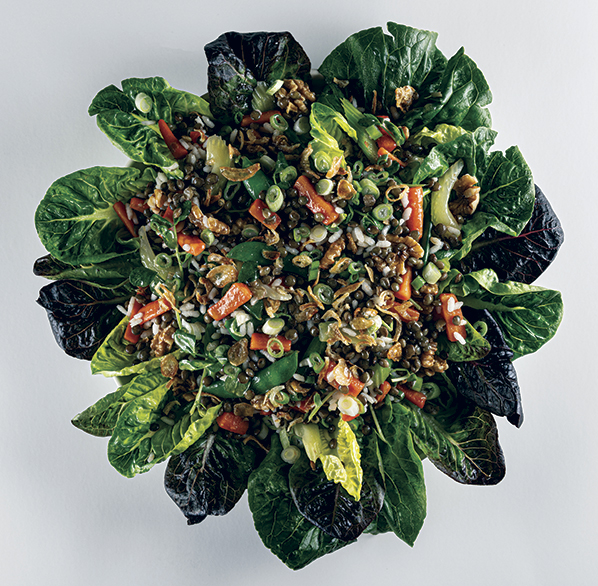
I have been a fan of lentils since I first tasted them 30 years ago. I don’t remember the exact context, but I do remember them being served with rice and rehydrated dried figs—a combination that is still a favorite of mine. I have consumed and cooked many lentils since then, and at this time of year, I love to pair them with whatever good spring vegetables I can get my hands on. This early in the season, a quick trip to an Asian market usually satisfies the spring cravings, because Asian markets always have the best spring produce (at the best price) you can find in our area.
The type of lentils you choose will directly influence your method of preparation (see In Your Pantry for more details). In an ideal world, French green lentils would be my choice, but “ordinary” green or brown lentils will do if that’s what you can get. Red lentils will not work for this dish as they will turn into a purée no matter how you cook them (they’re better off saved for a soup). After the procurement of fresh greens and lentils, the rest of the dish almost composes itself. I like to use rice when cooking with lentils (or any other legume) because together they make a chemically complete protein similar to meat, but without all of the saturated fats and cholesterol. The type of rice is up to you, as are the vegetables and garnishes for this satisfying salad, a recipe that I hope will bring you as many years of enjoyment as lentils have brought me.
Salad of Lentils, Rice, and Spring Flavors
Chances are, if you have dried lentils in the cupboard and a few odds and ends in the fridge, you can assemble this humble dish without leaving home. Begin by cooking the lentils. I like to cook lentils in lightly salted water in a ratio of 1 part lentils to 3 parts water (or flavorful broth) with a fresh bay leaf and a drizzle of extra-virgin olive oil. Sturdy French lentils will take a good 15 minutes to cook, sometimes up to 25. Standard green or brown lentils can take less time—as with all dried legumes, the longer they are in storage, the longer they will take to cook. After 10 minutes, begin tasting the lentils to check for doneness. Lentils for a salad should have a nice bite, so as soon as they have reached the desired texture, strain them and spread them out on a large plate or pan to cool. For the rice and any vegetables that need cooking, bring a medium-sized pot of lightly salted water to a boil (also with a little oil and a bay leaf). Celery, carrots, and onion are common kitchen staples that are welcome in this salad year round, so peel and cut them into small bite-sized pieces (it doesn’t take much). Snow peas and sugar snap peas are lovely this time of year, so a handful of them, strings or tough stems removed, cut in half if they are on the large size, would be perfect, but a cup or so of frozen English peas would work in a pinch. Drop the vegetables into the boiling water and cook for 1 minute after the water comes back to a boil. With a spider or slotted spoon, remove the vegetables to a bowl of ice water to stop the cooking and retain the beautiful bright colors and flavors. In the same boiling cooking water, add a large handful of rice (I like Carnaroli or Arborio for salads, but Basmati, Jasmine, plain white or even brown will work—your choice) and cook for about 10 minutes, testing for texture at about the 8 minute mark (brown rice will take considerably longer, up to 40 minutes). Strain the rice (reserving the cooking water, which would now be an excellent base for a light soup) and spread it out to cool like the lentils. Drain the chilled vegetables and pat them dry with a towel.
In a spacious, wide bowl, combine the rice, lentils, and cooked vegetables. Make a vinaigrette with good red wine vinegar ( or white wine vinegar, or lemon juice) and extra-virgin olive oil in a ratio of one third vinegar to two thirds oil. Generously dress the thirsty rice and lentils with the vinaigrette and toss thoroughly, adjusting the seasoning with salt and pepper as necessary. The salad is delicious as is, but the excitement really comes with extra garnishes. I love to add any type of toasted nut (even a can of salted and roasted mixed nuts). Chopped green onions, parsley, cilantro, or other herbs—some of those fresh hints of green out in the garden like wild fennel or new growth chives—would add interest and a little surprise. Pea tendrils, bean sprouts, and shredded or wilted spinach would bring freshness. Or perhaps whole lettuce leaves put around the edge to use as a wrap for hand-held salad (I love the diminutive “artisan” lettuce heads available in many grocery stores now, especially the crunchy Little Gem). Even Belgian endive leaves (or tortilla chips!) could serve as a scoop for a buffet presentation. To gild the lily, fried onions or shallots would provide even more savory crunch. And for those who can’t imagine a meal without animal protein, practically any type of meat would harmonize with this salad, as would just about any cheese. The combinations and variations really are infinite. This salad is best at room temp, and although the textures might suffer a little, it will keep for several days in the fridge, making it a healthful and excellent go-to meal when you’re hungry, tired, and short on time.
In Your Pantry: So Many Lentils
Lentils, a source of high quality protein and fiber, are one of the oldest known crops cultivated for human consumption—for between seven and 12 thousand years. Over the millennia, numerous varieties with different characteristics have been developed/encouraged according to use and climate. Although this evolution has resulted in a chaos of names and classifications (try searching lentils on the internet and you’ll soon notice the confusion and conflicting information), a little quality time in the kitchen with this humble legume will clarify much of the confusion. Here are some basic guidelines for lentil shopping.
 Green and Brown
Green and Brown
These are the “ordinary” lentils, sometimes simply labeled as “lentils,” the color differences of these pale legumes being almost indistinguishable. They are wonderful in that, unlike many other legumes, lentils do not require soaking before cooking, making them ideal for quick meals. If they were to be overcooked (and become a little mushy and ragged) they make a great vegetarian burger (just Google for countless recipes). They are higher in protein per gram than beef and are lower in indigestible sugars than beans (with a lower flatulence factor). If time is not of the essence, soaking them with a little salt (one teaspoon salt to four cups water) for one hour before cooking will help them hold their shape. Gentle cooking in the oven (as opposed to a boil on the stove top) is another helpful technique.
 Fancy Lentils
Fancy Lentils
All lentils are not created equal. The Puy lentil, a variety of green lentil developed in the Puy region of France, is small and peppery with a deep mottled green color and an intense flavor. They are extremely resilient when cooked and lend themselves to preparations where firm texture is important. They are one of the most nutrient dense kinds of lentil, and as with other lentils associated with places, are relatively expensive. Laird lentils, another green French variety mostly grown in Canada, are also quite sturdy, but with a milder flavor. The Italians also have a fancy (expensive) brown lentil from Umbria with similar cooking qualities. The most visually dramatic lentils are the Black Beluga or Caviar lentils, tiny, with a sturdy texture but tender skin.
 Red and Crimson
Red and Crimson
Red lentils are a type of brown lentil that has had its skin removed (decorticated) and is usually split. They cook very quickly, turning a golden color and dissolve into a purée, making them ideal for soups. Red lentils (and practically all other types of lentil) are a staple in India, a country with an extensive legume repertoire where they are called dal, a word which references both the lentil and a dish made from lentils. Red lentils with their skin are often called Crimson lentils, which are a specialty in Turkey.


